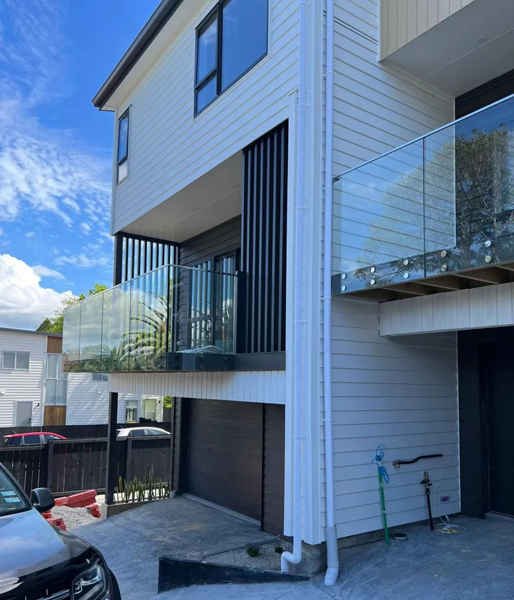Introduction
Glass railings are a popular choice in modern architecture, offering sleek aesthetics and unobstructed views. However, the installation process of glass railings is critical to ensuring their safety, durability, and appearance. Many homeowners and contractors alike make common mistakes during installation that can lead to safety hazards, structural issues, or costly repairs. This article will highlight the five most common mistakes made during the installation of glass railings and provide practical solutions and tips to avoid them.
1. Inaccurate Measurements
Mistake:
One of the most common mistakes during glass railing installation is inaccurate measurements. Even the slightest miscalculation can result in glass panels that do not fit properly, leading to gaps, misalignment, or the need for expensive modifications.
How to Avoid It:
- Double-Check Measurements: Always double-check all measurements before ordering glass panels. Ensure that you measure the exact height, width, and thickness required for each panel.
- Consider Tolerances: Allow for manufacturing tolerances by slightly adjusting your measurements. Consult with your glass supplier to understand the tolerances they work within and factor these into your planning.
- Use Templates: For complex installations, especially on curved or angled surfaces, create templates using materials like plywood or cardboard to ensure that the glass panels will fit perfectly when they arrive.
Case Example:
A contractor ordered custom glass panels for a staircase but failed to account for the angle of the steps. As a result, the panels were too short, causing gaps between the bottom of the glass and the steps. The issue was resolved by ordering new panels, but it led to delays and additional costs.
2. Improper Handling of Glass Panels
Mistake:
Glass panels are fragile and can be easily damaged if not handled properly during installation. Scratches, chips, or even cracks can occur if the panels are mishandled, leading to compromised safety and aesthetics.
How to Avoid It:
- Use Proper Equipment: Always use appropriate equipment, such as glass suction cups, to handle the panels safely. Avoid dragging the glass across rough surfaces that could cause scratches.
- Protective Gear: Wear protective gloves and ensure that the installation area is clear of debris that could damage the glass.
- Careful Placement: Place the glass panels on padded surfaces when setting them down, and avoid leaning them against hard objects that could cause chips or cracks.
Case Example:
During a balcony railing installation, a glass panel was accidentally dropped and chipped at the corner. The panel had to be replaced, delaying the project and increasing costs. To prevent future incidents, the installation team invested in better glass handling equipment and implemented stricter safety protocols.
3. Ignoring Building Codes and Regulations
Mistake:
Failing to adhere to local building codes and regulations is a critical mistake that can lead to safety issues, fines, or even the need to remove and reinstall the entire railing system. Building codes specify requirements for height, load-bearing capacity, and spacing between glass panels.
How to Avoid It:
- Research Local Codes: Before starting any installation, thoroughly research and understand the local building codes and regulations that apply to glass railings in your area.
- Consult with Experts: If you’re unsure about specific regulations, consult with a building inspector or a professional contractor who is familiar with local requirements.
- Obtain Permits: Ensure that all necessary permits are obtained before beginning the installation. This will help avoid legal issues and ensure that the installation meets all safety standards.
Case Example:
A homeowner installed glass railings on their deck without checking the local building codes. The railings were too low, and the gaps between the panels were too wide, posing a safety risk. The local building authority required the homeowner to replace the entire railing system to meet code, resulting in significant additional expenses.
4. Incorrect Installation of Mounting Hardware
Mistake:
Improperly installed mounting hardware is a common issue that can compromise the stability and safety of glass railings. This can include incorrectly positioned anchors, loose bolts, or the use of inappropriate materials that are not designed to support the weight of the glass.
How to Avoid It:
- Use the Right Tools: Ensure that you are using the correct tools and hardware specified for the installation. This may include specialized anchors, bolts, or brackets designed to support the weight and size of the glass panels.
- Follow Manufacturer Instructions: Always follow the manufacturer’s instructions when installing mounting hardware. If instructions are unclear, seek advice from the manufacturer or a professional installer.
- Securely Fasten Hardware: Double-check that all hardware is securely fastened and that the anchors are properly embedded in the supporting structure. Regularly inspect the hardware during and after installation to ensure stability.
Case Example:
A commercial building installed glass railings in its lobby, but the contractors used standard drywall anchors instead of heavy-duty anchors suitable for glass panels. Over time, the railings became loose, posing a safety risk. The building had to undergo costly repairs to replace the hardware and re-secure the railings.
5. Poor Alignment and Leveling
Mistake:
Poor alignment and leveling during installation can result in a visually unappealing and structurally unsound glass railing system. Misaligned panels can cause stress on the glass, leading to cracks or breakage, and can detract from the overall aesthetic of the space.
How to Avoid It:
- Use a Level: Always use a level during installation to ensure that each glass panel is perfectly aligned both horizontally and vertically.
- Check Alignment Frequently: Regularly check the alignment of the panels as you proceed with the installation. Adjustments should be made immediately if any discrepancies are detected.
- Start with a Strong Foundation: Ensure that the base where the glass panels will be installed is level and stable. Any unevenness in the foundation should be corrected before installation begins.
Case Example:
During a high-end residential project, a contractor failed to properly level the base for the glass railing on a terrace. As a result, the glass panels were misaligned, and the entire system had to be dismantled and reinstalled, leading to significant delays and increased costs.
Conclusion
Installing glass railings requires careful attention to detail and adherence to best practices to ensure safety, durability, and aesthetic appeal. By avoiding common mistakes such as inaccurate measurements, improper handling of glass, ignoring building codes, incorrect installation of mounting hardware, and poor alignment, you can ensure a successful and problem-free installation. Learning from the experiences of others and following the tips provided in this article will help you achieve a flawless glass railing installation that enhances the beauty and safety of any space.







